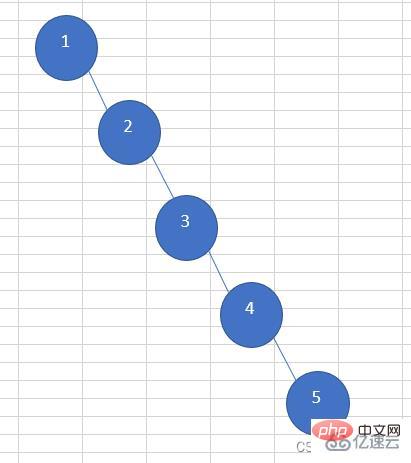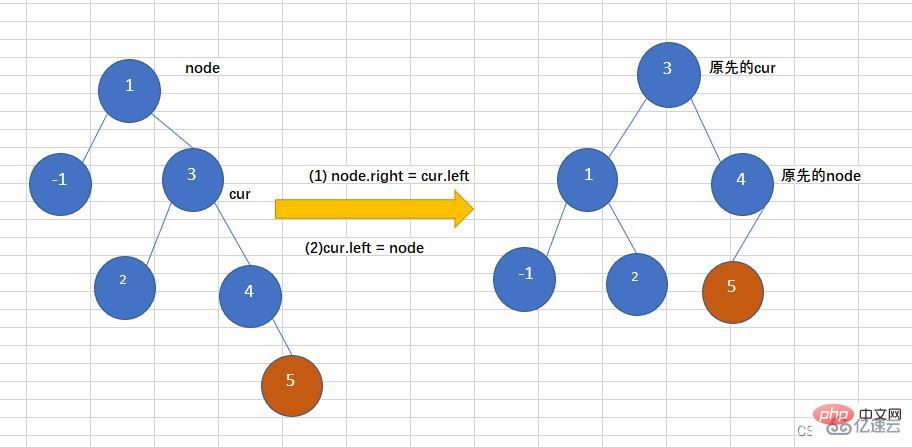Java data structure AVL tree example analysis

Introduction of AVL tree
Searching a binary tree has extremely high search efficiency, but searching a binary tree will result in the following extreme situations: 
Like this The search efficiency of binary tree is even lower than that of linked list. The balanced binary tree (AVL tree) that appears based on the search binary tree solves this problem. When the absolute value of the height difference between the left and right subtrees of a node in a balanced binary tree (AVL tree) is greater than 1, their height difference will be reduced through a rotation operation.
Basic concept
The AVL tree is essentially a binary search tree. Its characteristics are:
itself is first a
binary search tree.The absolute value (balance factor) of the difference between the
heights of the left and right subtrees of each node is at most 1. In other words, the AVL tree is essentially a binary search tree (binary sorting tree, binary search tree) withbalancing function.When inserting a node or deleting a node, the absolute value of the height difference between the left and right subtrees of a node is greater than 1. In this case, you need to pass
Left rotationandRight rotationoperation makes the binary tree reach a balanced state again.
Balance Factor (balanceFactor)
The left subtree and right subtree of a node
The height difference is.The BF of any node in the AVL tree can only be
-1, 0 and 1.
Basic design
The following are the simple methods and attributes required by the AVL tree:
public class AVLTree <E extends Comparable<E>>{
class Node{
E value;
Node left;
Node right;
int height;
public Node(){}
public Node(E value){
this.value = value;
height = 1;
left = null;
right = null;
}
public void display(){
System.out.print(this.value + " ");
}
}
Node root;
int size;
public int size(){
return size;
}
public int getHeight(Node node) {
if(node == null) return 0;
return node.height;
}
//获取平衡因子(左右子树的高度差,大小为1或者0是平衡的,大小大于1不平衡)
public int getBalanceFactor(){
return getBalanceFactor(root);
}
public int getBalanceFactor(Node node){
if(node == null) return 0;
return getHeight(node.left) - getHeight(node.right);
}
//判断一个树是否是一个平衡二叉树
public boolean isBalance(Node node){
if(node == null) return true;
int balanceFactor = Math.abs(getBalanceFactor(node.left) - getBalanceFactor(node.right));
if(balanceFactor > 1) return false;
return isBalance(node.left) && isBalance(node.right);
}
public boolean isBalance(){
return isBalance(root);
}
//中序遍历树
private void inPrevOrder(Node root){
if(root == null) return;
inPrevOrder(root.left);
root.display();
inPrevOrder(root.right);
}
public void inPrevOrder(){
System.out.print("中序遍历:");
inPrevOrder(root);
}}RR(Left-handed)
Insert a node into the right subtree of the right subtree of a tree, causing the binary tree to become unbalanced, as shown below. Insert 5 into the balanced binary tree, causing the tree to become unbalanced. At this time, a left-turn operation is required, as follows: 
The code is as follows:
//左旋,并且返回新的根节点
public Node leftRotate(Node node){
System.out.println("leftRotate");
Node cur = node.right;
node.right = cur.left;
cur.left = node;
//跟新node和cur的高度
node.height = Math.max(getHeight(node.left),getHeight(node.right)) + 1;
cur.height = Math.max(getHeight(cur.left),getHeight(cur.right)) + 1;
return cur;
}LL (right rotation)
Insert a node into the left subtree of the left subtree of an AVL tree, causing the binary tree to become It is not balanced, as shown below. Insert 2 into the balanced binary tree, causing the tree to become unbalanced. At this time, a left-turn operation is required, as follows: 
The code is as follows:
//右旋,并且返回新的根节点
public Node rightRotate(Node node){
System.out.println("rightRotate");
Node cur = node.left;
node.left = cur.right;
cur.right = node;
//跟新node和cur的高度
node.height = Math.max(getHeight(node.left),getHeight(node.right)) + 1;
cur.height = Math.max(getHeight(cur.left),getHeight(cur.right)) + 1;
return cur;
}LR (First rotate left and then rotate right)
Insert a node into the right subtree of the left subtree of the AVL tree. As a result, the tree is no longer balanced. You need to first correct the left subtree. Perform left rotation , and then rotate the entire tree right , as shown in the figure below, insert node 5.
RL (first rotate right and then rotate left)
Insert a node into the left subtree of the AVL treeright subtree, causing the tree to no longer be balanced. You need to right-rotate the right subtree first. Then left-rotate the entire tree, as shown in the figure below, insert node 2.
Add node
//添加元素
public void add(E e){
root = add(root,e);
}
public Node add(Node node, E value) {
if (node == null) {
size++;
return new Node(value);
}
if (value.compareTo(node.value) > 0) {
node.right = add(node.right, value);
} else if (value.compareTo(node.value) < 0) {
node.left = add(node.left, value);
}
//跟新节点高度
node.height = Math.max(getHeight(node.left), getHeight(node.right)) + 1;
//获取当前节点的平衡因子
int balanceFactor = getBalanceFactor(node);
//该子树不平衡且新插入节点(导致不平衡的节点)在左子树的左子树上,此时需要进行右旋
if (balanceFactor > 1 && getBalanceFactor(node.left) >= 0) {
return rightRotate(node);
}
//该子树不平衡且新插入节点(导致不平衡的节点)在右子树子树的右子树上,此时需要进行左旋
else if (balanceFactor < -1 && getBalanceFactor(node.right) <= 0) {
return leftRotate(node);
}
//该子树不平衡且新插入节点(导致不平衡的节点)在左子树的右子树上,此时需要先对左子树左旋,在整个树右旋
else if (balanceFactor > 1 && getBalanceFactor(node.left) < 0) {
node.left = leftRotate(node.left);
return rightRotate(node);
}
//balanceFactor < -1 && getBalanceFactor(node.left) > 0
//该子树不平衡且新插入节点(导致不平衡的节点)在右子树的左子树上,此时需要先对右子树右旋,再整个树左旋
else if(balanceFactor < -1 && getBalanceFactor(node.right) > 0) {
node.right = rightRotate(node.right);
return leftRotate(node);
}
return node;
}Delete node
//删除节点
public E remove(E value){
root = remove(root,value);
if(root == null){
return null;
}
return root.value;
}
public Node remove(Node node, E value){
Node retNode = null;
if(node == null)
return retNode;
if(value.compareTo(node.value) > 0){
node.right = remove(node.right,value);
retNode = node;
}
else if(value.compareTo(node.value) < 0){
node.left = remove(node.left,value);
retNode = node;
}
//value.compareTo(node.value) = 0
else{
//左右节点都为空,或者左节点为空
if(node.left == null){
size--;
retNode = node.right;
}
//右节点为空
else if(node.right == null){
size--;
retNode = node.left;
}
//左右节点都不为空
else{
Node successor = new Node();
//寻找右子树最小的节点
Node cur = node.right;
while(cur.left != null){
cur = cur.left;
}
successor.value = cur.value;
successor.right = remove(node.right,value);
successor.left = node.left;
node.left = node.right = null;
retNode = successor;
}
if(retNode == null)
return null;
//维护二叉树平衡
//跟新height
retNode.height = Math.max(getHeight(retNode.left),getHeight(retNode.right));
}
int balanceFactor = getBalanceFactor(retNode);
//该子树不平衡且新插入节点(导致不平衡的节点)在左子树的左子树上,此时需要进行右旋
if (balanceFactor > 1 && getBalanceFactor(retNode.left) >= 0) {
return rightRotate(retNode);
}
//该子树不平衡且新插入节点(导致不平衡的节点)在右子树子树的右子树上,此时需要进行左旋
else if (balanceFactor < -1 && getBalanceFactor(retNode.right) <= 0) {
return leftRotate(retNode);
}
//该子树不平衡且新插入节点(导致不平衡的节点)在左子树的右子树上,此时需要先对左子树左旋,在整个树右旋
else if (balanceFactor > 1 && getBalanceFactor(retNode.left) < 0) {
retNode.left = leftRotate(retNode.left);
return rightRotate(retNode);
}
//该子树不平衡且新插入节点(导致不平衡的节点)在右子树的左子树上,此时需要先对右子树右旋,再整个树左旋
else if(balanceFactor < -1 && getBalanceFactor(retNode.right) > 0) {
retNode.right = rightRotate(retNode.right);
return leftRotate(retNode);
}
return retNode;
}The above is the detailed content of Java data structure AVL tree example analysis. For more information, please follow other related articles on the PHP Chinese website!

Hot AI Tools

Undresser.AI Undress
AI-powered app for creating realistic nude photos

AI Clothes Remover
Online AI tool for removing clothes from photos.

Undress AI Tool
Undress images for free

Clothoff.io
AI clothes remover

Video Face Swap
Swap faces in any video effortlessly with our completely free AI face swap tool!

Hot Article

Hot Tools

Notepad++7.3.1
Easy-to-use and free code editor

SublimeText3 Chinese version
Chinese version, very easy to use

Zend Studio 13.0.1
Powerful PHP integrated development environment

Dreamweaver CS6
Visual web development tools

SublimeText3 Mac version
God-level code editing software (SublimeText3)

Hot Topics
 1386
1386
 52
52
 Perfect Number in Java
Aug 30, 2024 pm 04:28 PM
Perfect Number in Java
Aug 30, 2024 pm 04:28 PM
Guide to Perfect Number in Java. Here we discuss the Definition, How to check Perfect number in Java?, examples with code implementation.
 Weka in Java
Aug 30, 2024 pm 04:28 PM
Weka in Java
Aug 30, 2024 pm 04:28 PM
Guide to Weka in Java. Here we discuss the Introduction, how to use weka java, the type of platform, and advantages with examples.
 Smith Number in Java
Aug 30, 2024 pm 04:28 PM
Smith Number in Java
Aug 30, 2024 pm 04:28 PM
Guide to Smith Number in Java. Here we discuss the Definition, How to check smith number in Java? example with code implementation.
 Java Spring Interview Questions
Aug 30, 2024 pm 04:29 PM
Java Spring Interview Questions
Aug 30, 2024 pm 04:29 PM
In this article, we have kept the most asked Java Spring Interview Questions with their detailed answers. So that you can crack the interview.
 Break or return from Java 8 stream forEach?
Feb 07, 2025 pm 12:09 PM
Break or return from Java 8 stream forEach?
Feb 07, 2025 pm 12:09 PM
Java 8 introduces the Stream API, providing a powerful and expressive way to process data collections. However, a common question when using Stream is: How to break or return from a forEach operation? Traditional loops allow for early interruption or return, but Stream's forEach method does not directly support this method. This article will explain the reasons and explore alternative methods for implementing premature termination in Stream processing systems. Further reading: Java Stream API improvements Understand Stream forEach The forEach method is a terminal operation that performs one operation on each element in the Stream. Its design intention is
 TimeStamp to Date in Java
Aug 30, 2024 pm 04:28 PM
TimeStamp to Date in Java
Aug 30, 2024 pm 04:28 PM
Guide to TimeStamp to Date in Java. Here we also discuss the introduction and how to convert timestamp to date in java along with examples.
 Java Program to Find the Volume of Capsule
Feb 07, 2025 am 11:37 AM
Java Program to Find the Volume of Capsule
Feb 07, 2025 am 11:37 AM
Capsules are three-dimensional geometric figures, composed of a cylinder and a hemisphere at both ends. The volume of the capsule can be calculated by adding the volume of the cylinder and the volume of the hemisphere at both ends. This tutorial will discuss how to calculate the volume of a given capsule in Java using different methods. Capsule volume formula The formula for capsule volume is as follows: Capsule volume = Cylindrical volume Volume Two hemisphere volume in, r: The radius of the hemisphere. h: The height of the cylinder (excluding the hemisphere). Example 1 enter Radius = 5 units Height = 10 units Output Volume = 1570.8 cubic units explain Calculate volume using formula: Volume = π × r2 × h (4
 Create the Future: Java Programming for Absolute Beginners
Oct 13, 2024 pm 01:32 PM
Create the Future: Java Programming for Absolute Beginners
Oct 13, 2024 pm 01:32 PM
Java is a popular programming language that can be learned by both beginners and experienced developers. This tutorial starts with basic concepts and progresses through advanced topics. After installing the Java Development Kit, you can practice programming by creating a simple "Hello, World!" program. After you understand the code, use the command prompt to compile and run the program, and "Hello, World!" will be output on the console. Learning Java starts your programming journey, and as your mastery deepens, you can create more complex applications.




